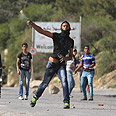
Riot in West Bank
צילום: גיל יוחנן
Strategic stone
Op-ed: Palestinians realize certain photos can cause more damage than anti-Israel resolutions in UN
A week ago I traveled through the Mount of Olives range, just a few meters below Hebrew University. Israeli territory, the capital city. Beside me sat former Defense Minister Moshe Arens. During our drive a young Palestinian who had just come out of his school in Abu Tor threw a stone at our car. On the way back another stone was thrown at the windshield. No damage was caused apart from a scratch on the windshield. In Israel no one remembers scratches. Most of the incidents pass beneath our radar. The victims are anonymous.
A month before the elections, videos were posted on social networks showing our soldiers in Kafr Qaddum and in a neighborhood in Hebron fleeing from a stone attack by young Palestinians. The images struck some exposed nerves. When soldiers run away from rocks – it sends a problematic message. When the common interest of the Palestinians and Israelis also runs away from rocks – the problem is more severe. The discussion surrounding the videos quickly faded. After years of empty promises of peace, many Israelis are no longer interested in what is going on in the West Bank. The elections ended, a government was formed, but the stones and videos are still with us.
Figures presented by the security establishment indicate that the third intifada is already here. It does not have a name, headline or public interest yet, but it is taking place. Over the past few months rocks have been flying in every corner. Israeli civilians are getting hurt, soldiers are dealing with violent protests. Despite what some elements in the radical Left believe, stones are not merely a symbol of a popular struggle. They have the potential to ignite the entire region. The only difference between a stone that kills and a stone that does not cause any real harm is luck.
The settlers are right when they claim that the escalation in Judea and Samaria must not be ignored. You don't have to be a supporter of the settlement enterprise to realize the potential of this escalation. Calm, by the way, is a real asset to those who are seeking diplomatic solutions. When there is fighting, it is hard to tell the difference between warmongers and proponents of peace.
The two previous intifadas caused damage to both sides. Blood directly affects the quality of life in Ramallah and Jerusalem. The Israeli economy, despite the deficit, will survive even if the violence intensifies. The Palestinian economy, on the other hand, will pay a price it cannot withstand.
A determined military operation is needed in order to stop the current round of violence. The not too distant past teaches us that the Palestinians know how to launch intifadas, but not how to end them. Israel, for its part, is facing the 'strategic stone' dilemma. As far as the Palestinian leadership is concerned, the stones are a continuation of the battle over the narrative and international public opinion. Photogenic violence. The Palestinians are looking for the right photo. A stone thrown by a Palestinian boy at a soldier who responds violently. In Ramallah you do not need the findings of the Israeli investigation into the Mohammed al-Dura incident to understand that certain photos cause more damage than anti-Israel resolutions in the UN.
Such a round of violence cannot be stopped with a light finger on the trigger against stone-throwing teenagers. It requires a wise finger – not only for moral purposes, but for utilitarian purposes as well.
As the frequency of the violent incidents increases, so will the military pressure. There is no other formula.










